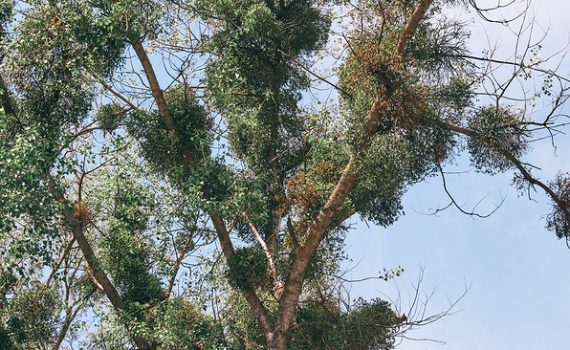Staying on top of mistletoe removal is especially important in Northern California where it’s a common annoyance for homeowners. Wild mistletoe can be found in many parts of North America, but it won’t grow on all tree species. It’s a parasitic evergreen shrub that draws water and mineral nutrients from a host tree, despite the fact that it does create some of its own energy through converting sunlight. Here’s a more in-depth look at this festive weed.
It’s For the Birds
Healthy bird populations mean more mistletoe plants. This is because birds spread mistletoe seeds when they ingest its white berries, which ripen in the winter. While poisonous to humans, mistletoe berries are an important food source for wildlife during the lean months when calories are scarce.
Seeds pass through the bird’s digestive system and stick to a tree branch. Additionally, some bird species even prefer to nest in mistletoe.
How Does Mistletoe Work?
Mistletoe can only survive on living trees. If the host tree dies, it won’t be able to feed any longer. Mistletoe doesn’t root in the earth. Rather, it has root-like structures that thread into tree branches, stealing resources. These organs are called haustoria.
Is Mistletoe Harmful to Trees?
Mistletoe grows slowly, so it’s not an immediate threat to the health of a tree. The greatest risk to a host tree is the water loss that incurs, especially while the weed is flowering or producing berries. Trees that are heavily infested with mistletoe can be killed if there are additional stressors, such as root damage, drought, or insects.
Do You Need Mistletoe Removal Services?
It’s easiest to spot mistletoe in the wintertime. It looks like a tangled green mass, usually connected to a bare tree branch.
Mistletoe Decorations
If you decide to use mistletoe in holiday decorations, be aware that its white berries are toxic and should be kept out of reach of curious children and pets.
Nontoxic Mistletoe Removal
While it’s easy to prune back mistletoe leaves and twigs, this won’t kill the entire plant because it’s also necessary to kill the roots. If the host tree is strong enough, one option is to simply remove infested branches. However, this can be harmful to trees so it’s best to consult with a certified arborist.
We hope you found this article helpful. To schedule a consultation, please contact our office at (925) 233-6877.
 Bringing Sexy Back Into Your Yards
Bringing Sexy Back Into Your Yards 
